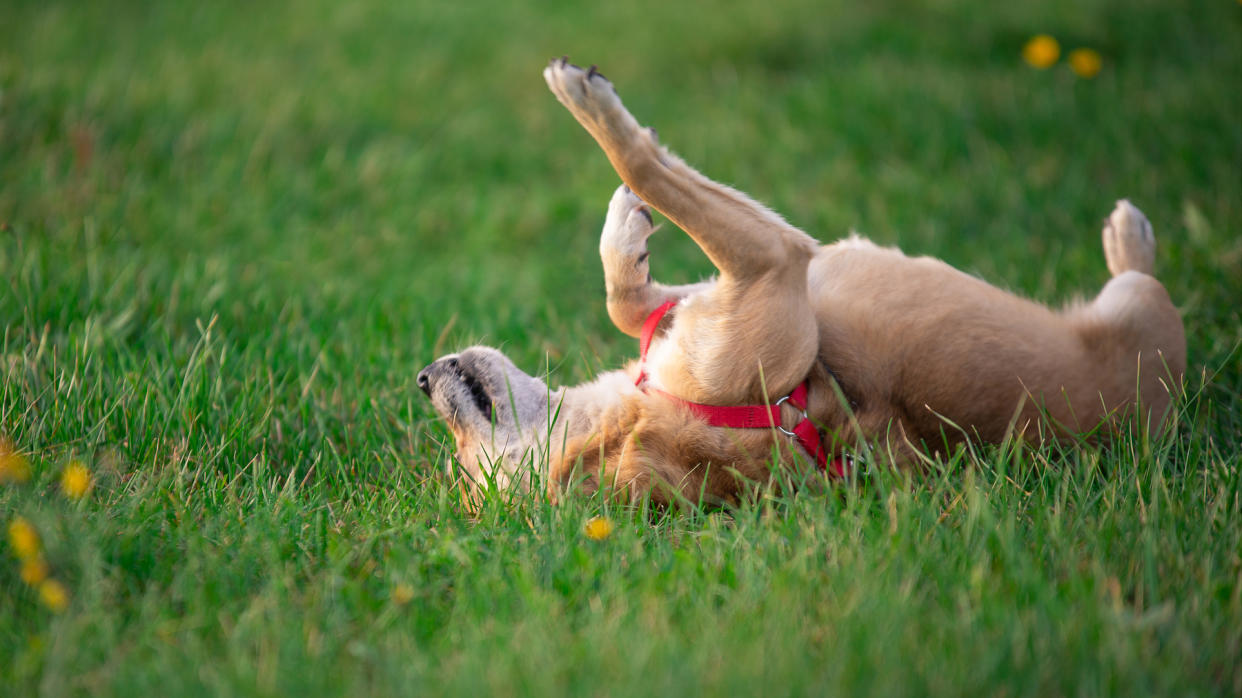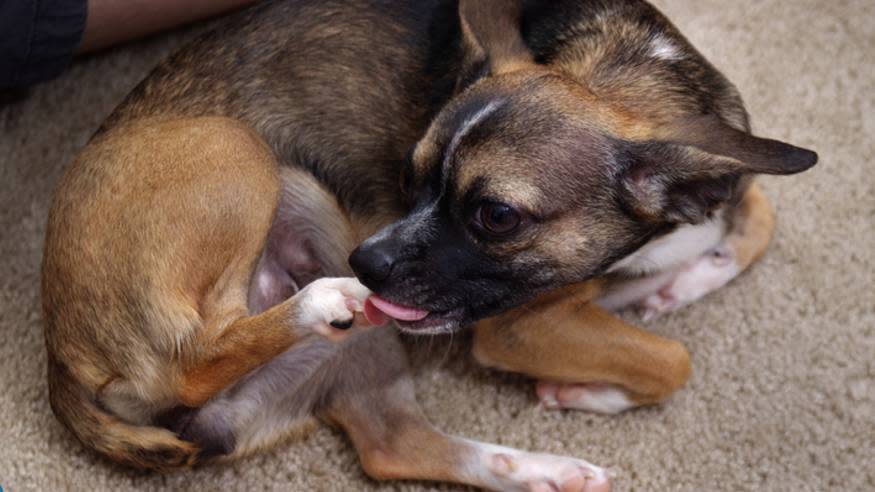Red paws on dogs: Vet shares key causes and treatments

While red paws on dogs is a common issue in dogs, they can cause discomfort, itchiness, and sometimes indicate underlying health conditions. We consulted Dr. Joanna Woodnutt MRCVS, a veterinarian specializing in dermatology, animal behavior, and nutrition, to provide her professional advice on identifying the causes of red paws and effective home treatments to alleviate irritation.
From allergies and anxieties to injuries and other health conditions, Joanna explains the factors that can contribute to red paws and offers expert insights on prevention measures and when it's necessary to seek veterinary care. When you have the knowledge on how to identify a pet emergency, you can make you, your pet and your vet’s life much easier.
According to a 2015 study published in the Canadian Veterinary Journal, front paws are more commonly affected than rear paws, and certain breeds like Pekingese, Terriers, and Labradors are more prone to paw diseases and dermatitis. However, regardless of your dog's breed, proper paw care is essential to prevent injuries and irritation while they explore the outdoors.
Without further ado, we are going to hand over to Dr Woodnutt, who will help to empower you with the necessary knowledge about red paws on dogs, and how to take proactive steps to keep your dog's paws in optimal condition.
What are the key signs of red paws on dogs
If you’re examining your dog’s paws and notice that they’re red, what else should you be on the look out for? Well, red paws on dogs are usually a sign that there’s more blood in the area than usual.
This can be due to inflammation or irritation, and sometimes a combination of both. Since dogs respond to irritation with licking, you’ll often find that irritated paws become inflamed.
Other signs you might see alongside red paws in your dog include:
Repetitive licking (find out more reasons behind 'why is my dog licking me?'), chewing, or gnawing
‘Flicking’ of feet (irritation)
Unwillingness to walk
Signs of irritation elsewhere – such as itchy ears
Foul smell
Saliva staining (pink fur where repeated licking is occurring, even if you don’t see the licking)
Don’t forget that many causes of red paws are painful, and your dog may not enjoy you taking a closer look. Take cues from your dog and don’t examine them if they aren’t happy about it, as even the nicest dog may bite if they’re painful.
Does my dog have pododermatitis?
Pododermatitis, or inflamed skin on the feet, is a medical condition that always stems from an underlying cause. While it's not a specific disease itself, it often manifests as red paws in dogs. If your dog displays redness on their paws, it is likely a sign of pododermatitis. However, it is crucial to consult with a veterinarian to identify and address the root cause behind this inflammation. The veterinarian will conduct a thorough examination to determine the specific underlying factors contributing to your dog's pododermatitis.
Causes of red paws on dogs

As discussed above, red paws can be a sign of a number of different problems.
Here’s a list of 12 different reasons dogs get red paws:
Allergies
Possibly the most common cause of red paws on dogs, allergies can cause feet to look red and become itchy.
Your dog might be biting or licking his paws repetitively. He may also be itchy elsewhere, or have irritated or infected ears.
Burns
In the summertime, burns from hot pavements are certainly a possible cause of red paws. Dogs with burned paws are likely to be painful – they may resent examination, so be careful. You might also see the pads peeling away. This usually affects all four paws equally.
Foreign body in the paw
At certain times of the year, a red, inflamed paw is often caused by a grass seed working its way under the skin and causing an infection.
Your dog will be licking repeatedly at the single paw and may be limping. It’s often difficult to find the entry hole as the skin heals over quickly, so don’t waste time looking for one. It’s also very sore, so take care not to get bitten whilst looking at your dog’s paws.
Claw bed infections
Infections in the nail bed can be extremely itchy, uncomfortable, and even painful. This is more likely to affect a single paw rather than all of them, and your dog will be licking and limping.
Claw bed infections are hard to see, so you might not see the infection itself.
Symmetrical Lupoid Onchodystrophy (SLO)
This unusual disease of the claws can cause pain, limping, and gnawing at the feet, resulting in red paws.
SLO is a condition where the claws don’t grow properly, they’re brittle, and they break easily. It affects all feet, but one may be worse than the others, especially if your dog has broken a nail. This condition is a consideration in dogs that have repeatedly damaged their nails.
Anxiety
Some people like to relate it to biting their nails, but some dogs with anxiety will repeatedly lick their paws, causing them to become red and inflamed.
This usually affects the front paws, or a single paw, and you might notice your dog has other behavioral changes such as pacing, changes in appetite, or clinginess.
Canine Cognitive Dysfunction (CCD)
CCD (aka ‘doggy dementia’) can cause red paws due to dogs repeatedly licking. The paws aren’t irritated themselves, but this soothing behavior causes them to become red and sore. Your dog might also show signs of night waking, anxiety, or forgetfulness.
Alabama rot
Strange scuffs and red marks on the paws are an early sign of the deadly disease Alabama rot, which often happens in the UK in autumn and winter, when it’s muddy.
Owners are advised to check their dog’s paws after walking and visit the vet if they see any red patches on the paws. It’s most likely to be a graze, but it’s worth checking!
Ticks
Ticks like to embed themselves between toes, where they often cause redness, irritation, and a limp. It’s best to get your veterinarian to remove ticks, especially when they’re in awkward locations, or use a ‘tick fork’ to get them out safely.
Demodectic mange
Demodex mites live at the base of hair follicles. Small numbers are fine, but large numbers occur in dogs that are otherwise immunocompromised (including puppies) and can cause the feet to become extremely irritated, red, and sore.
This usually affects pairs or all four feet and is more common in short-haired breeds and those with allergies or other immunocompromise.
Hookworms
These tiny worms burrow through the skin on the feet, causing red, itchy feet, before making their way to the gut to live. Hookworm infection is more common in dogs kept on concrete and dogs kept in groups, but it’s still rare in most areas.
Contact irritants
If your dog has walked on something that causes skin irritation, this can cause red paws. Road salt is irritating, and it can cause your dog’s paws to become red and itchy after a walk in winter.
It’s also toxic if ingested, so rinse it off quickly if your dog comes into contact with it. This cause of red paws is likely to affect all paws equally. Other potential irritants can include cleaning products and herbicides.
How to treat red dog paws at home

If your dog has red paws, you might be wondering how best to treat them at home. The first thing you should do if your dog has red paws is take a closer look. If you can see a wound or a damaged nail, it’s time for a vet visit.
If there’s no sign of a problem, you can try rinsing your dog's feet to remove any irritants or allergens. Then, watch your dog for some of the other symptoms discussed here.
If they seem to be continually licking or upset by their feet, you should visit a vet. It’s best not to apply anything to your dog’s feet until they’ve been seen by a vet, as it may make examination harder.
How to prevent red dog paws
Preventing red dog paws depends on the cause. If your dog has an underlying condition like allergies or SLO, keeping on top of their medication will help to prevent their paws from becoming irritated.
On the other hand, if your dog’s paws are red due to an injury or a foreign object, there’s not much you can do to stop them becoming red.
You can take care of your dog’s paws by choosing your walks carefully and avoiding hot pavements, road salt, and glass and other sharp objects. Dogs with feathered feet may need their fur trimming in summer to reduce the risk of them picking up grass awns or burrs.
Mud should also be avoided in some areas due to the risk of Alabama rot. When you get in from a walk, check your dog’s paws over carefully and remove any grass seeds, burrs, or other plant material.
Check between the toes for ticks. Give them a good rinse, then dry them thoroughly. Some dogs may also benefit from paw moisturizer.
When to visit your veterinarian
You should visit your veterinarian if your dog’s red paws persist for more than a couple of days or if they seem:
Painful
Irritated by them
Your vet will take a look at your dog’s paws and determine whether any investigations are needed.
Often, treatment can be offered in the initial consultation, but in some cases your dog may require an anaesthetic for x-rays or surgery to remove a foreign object.
Your dog’s paws are important. The saying ‘no foot, no horse’ also applies to dogs – a sore paw can quickly become a big problem if it’s not treated properly, and your dog will be miserable as a result.
Red paws on dogs are a warning sign that something isn’t right, so don’t ignore your instincts and visit your vet if you spot a problem, especially if it doesn’t improve with some basic home care.